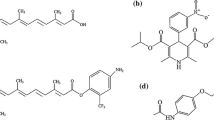It was established that about 30% of the administered dose of tetramezine was bound to plasma proteins in healthy donors. This should not significantly influence the strength of its pharmacological action in the absence of binding to blood cellular components.
Similar content being viewed by others
Avoid common mistakes on your manuscript.
The binding of pharmacological compounds to plasma proteins must be quantified in order to interpret data regarding their free plasma concentration [1]. Tetramezine (I) [2] is a bisdiaziridine [N,N′-ethylene-bis(3,3-dimethyldiaziridine], an original class of chemical compounds, and a white crystalline powder with a yellowish tint and a melting point of 118 – 119°C (Me2CO). The compound is readily soluble in H2O and alcohol and soluble in CHCl3. The pH of its aqueous solution is 6.2 – 8.2.

Experimental Biological Part
The interaction of I with plasma proteins was studied by equilibrium dialysis [30 samples of blood from 10 healthy donors that was stabilized by sodium citrate solution (5%) was used]. The plasma was obtained by centrifuging the blood for 10 min at 3,000 rpm.
The semi-permeable membrane consisted of Kuprofan film, which is used for hemodialysis in an Artificial Kidney apparatus. Before the start of the experiment, the membrane was stored for 1 d in Trilon B solution (0.005 M), rinsed with warm distilled H2O, and wetted with phosphate buffer solution, which was prepared by adding NaOH solution (0.1 M) to KH2PO4 solution (50 mL, 0.1 M) until the pH was 7.4. Table 1 presents the concentrations of I in the phosphate buffer solution. The concentration of I in the outer chamber and in the outer and inner chambers in the control tests was determined by GC [3].
The solution of I in phosphate buffer (6 mL) was placed into the outer chamber of the dialysis apparatus; plasma (2 mL), in the inner chamber. The liquid levels in both chambers were aligned. The apparatus was placed into a thermostat at 37°C for 1 and 3 h. Control tests were performed simultaneously. For this, phosphate buffer (2 mL) instead of plasma was placed into the inner chamber. Table 1 presents results from determinations (all tests were repeated five times) of the concentration of I in the inner and outer chambers for three starting drug concentrations.
Table 1 shows that equilibrium between free I and that bound to proteins was established in 1 h. The binding of I to plasma proteins was about 30% in the concentration range from 20 to 300 μg/mL.
Results and Discussion
The results from the in vitro studies of the binding of pharmacological compounds to blood proteins cannot be automatically extrapolated to the clinical setting. It is currently thought [4] that changes in the binding of drugs to plasma proteins, the distribution volumes of which are small (~0.2 L/kg) and the bindings to plasma proteins of which are high (90% and greater), will be clinically significant.
Recalling that the binding of I determined by us in the in vitro experiment was of the order of 30% and the fact that the distribution volume of I after oral administration is 0.673 L/kg [5], it could be assumed that binding to proteins had practically no influence on the strength of the pharmacological action of I in a clinical setting in the absence of its binding to blood cellular components.
References
E. Begg, Clinical Pharmacology [in Russian], BINOM, Moscow (2004), p. 20.
A. A. Prokopov, L. I. Kotlova, and A. S. Berlyand, Khim.-farm. Zh., 40(9), 3 – 4 (2006); Pharm. Chem. J., 40(9), 463 – 464 (2006).
A. A. Prokopov, L. I. Kotlova, and A. S. Berlyand, Khim.-farm. Zh., 41(1), 8 – 9 (2007); Pharm. Chem. J., 41(1), 7 – 9 (2007).
D. G. Shand, D. W. Kornhauser, and G. R. Wilkinson, J. Pharm. Exp. Ther., V, 424 – 432 (1975).
A. A. Prokopov, L. I. Kotlova, and A. S. Berlyand, Khim.-farm. Zh., 39(7), 8 – 12 (2005); Pharm. Chem. J., 39(7), 8 – 12 (2005).
Author information
Authors and Affiliations
Additional information
Translated from Khimiko-Farmatsevticheskii Zhurnal, Vol. 49, No. 6, pp. 55 – 56, June, 2015.
Rights and permissions
About this article
Cite this article
Belyak, L.I., Berlyand, A.S. & Prokopov, A.A. Investigation of Tetramezine Binding to Plasma Proteins in Healthy Donors. Pharm Chem J 49, 417–418 (2015). https://doi.org/10.1007/s11094-015-1297-6
Received:
Published:
Issue Date:
DOI: https://doi.org/10.1007/s11094-015-1297-6




